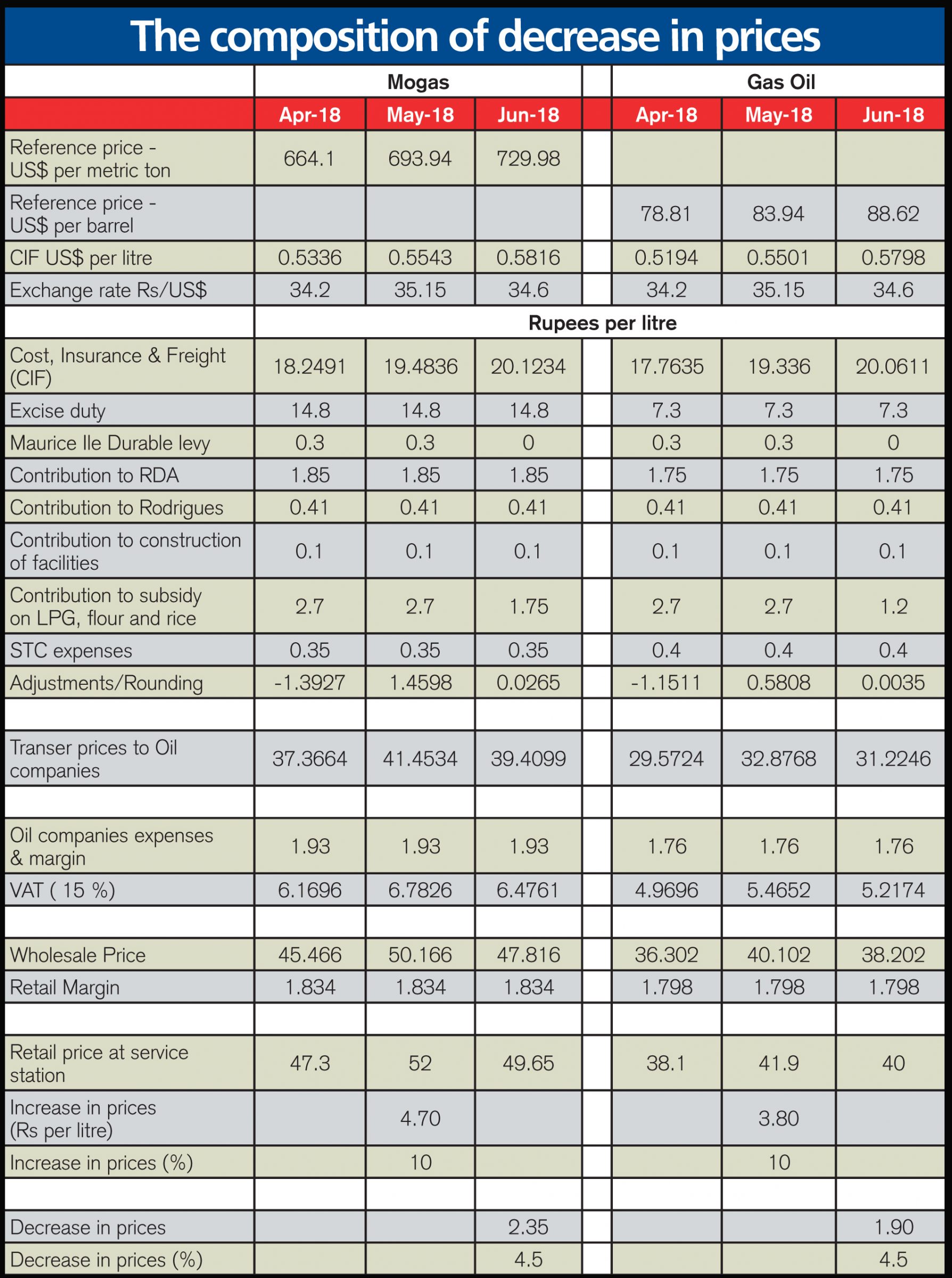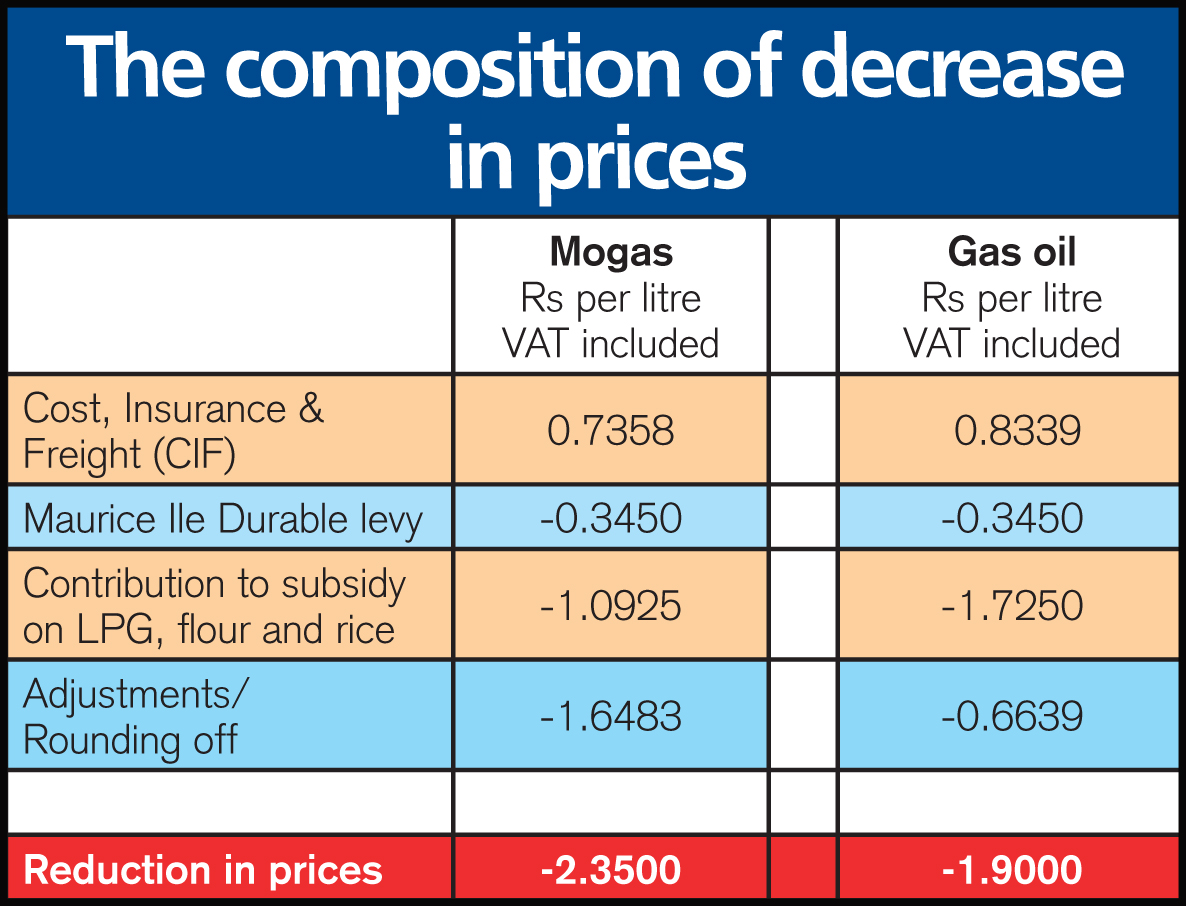Publicité
Budget 2018-19: The tricks in mogas and diesel prices
Par
Partager cet article
Budget 2018-19: The tricks in mogas and diesel prices

1. The cynicism of rising and falling prices within one month
One is tempted to commiserate with Minister Gungah. He was despatched to the trenches to justify why the prices of petroleum products skyrocketed in mid- May 2018. He expatiated on the impotence of the country in the face of rising costs on the world market to posit that government had no other choice than to raise the retail prices of motor gas (mogas) and diesel by 10%. Yet, one month later, the Minister of Finance, rather than the Petroleum Pricing Committee or Minister Gungah, pulls a rabbit out of his hat and lowers the prices of mogas and gas oil inspite of slightly higher costs of petroleum products between May and June 2018. One wonders why what has been mentioned in the Budget could not be accomplished in May to mitigate the impact on the prices of mogas and gas oil? For instance, why on earth were the prices not simply raised by only 5% in May from Rs 47.30 to Rs 49.65 per litre of mogas and from Rs 38.10 to Rs 40 per litre of gas oil? Instead of the convoluted 10% hike in May followed by a news-grabbing decline of 4.5% one month later.
2.The riddle of the reduction of 4.5% in June 2018 after a rise of 10% in May 2018
In the 2018-19 Budget, the Minister of Finance announced a reduction of Rs 2.35 per litre of mogas (4.5%) and Re 1.90 per litre of gas oil (4.5%). This came after an increase of Rs 4.70 per litre of mogas (10%) and Rs 3.80 per litre of gas oil (10%) in May 2018. The fall in prices in June 2018 is exactly 50% of the increase in May 2018. Is it sheer coincidence or is it by design? Why did the country have to go through the trauma of a significant rise in prices to be followed 30 days later by a drop in these same prices when the fundamentals of petroleum products on the world market have not changed much? In fact, the actual CIF costs of petroleum products have firmed up by around 3.5% between May and June 2018 while the retail prices have come down by 4.5%.
Most people had urged government to review one major item of taxation that has a huge impact on the retail prices of petroleum products. The excise duty at Rs 17.02 per litre (Rs 14.8 augmented by 15% VAT) accounts for 34% of the retail price of mogas. It is at Rs 8.40 per litre of diesel (Rs 7.3 adjusted for 15% VAT) and represents 21% of the final price. Some people had also proposed a reduction in the contribution made for the subsidy on the prices of rice, flour and cooking gas at Rs 2.70 per litre of mogas and gas oil while few had called for the abolition of the contribution to the Maurice île durable (MID) Fund of Re 0.3 per litre.
3. The rationale underpinning the three claims
The basis for such demands are grounded on the following
i) In January 2015, when the prices of petroleum products fell sharply, instead of passing on the decrease to consumers, government increased the Build Mauritius Fund by Rs 3 per litre from Re 1 to Rs 4 per litre of mogas and diesel. The leader of the Opposition, who was DPM in 2015, has stated that there was an understanding that this special levy of Rs 3 per litre would be removed when prices go up. Since last year, the Build Mauritius Fund levy (Rs 4 per litre) has been amalgamated with the excise duty (Rs 10.8 per litre) to become a new excise duty of Rs 14.80 per litre of mogas and Rs 7.30 per litre of gas oil;
ii) In November 2015, there was another significant drop in oil prices. Again, instead of transferring it to motorists, government raised the contribution for subsidy on rice, flour and cooking gas from Re 1.50 to Rs 2.70 per litre. Hardly 30% of that fund has been used for its intended purpose and a sizeable amount has been paid as dividends to government by the STC;
iii)The MID project has been scrapped by government. Yet, it continued to levy Re 0.30 per litre of petroleum products, with the amount being credited to the Ministry of Finance. Most people were expecting a reduction in the excise duty to reflect a lower contribution to the former Build Mauritius Fund from Rs 4 per litre to Re 1 per litre so as to mirror what it was in January 2015. In addition to the abolition of the MID levy coupled with the restoration of the contribution for the subsidy on rice, flour and cooking gas to its pre-November 2015 level of Re 1.50 per litre.
The mystery of the fall in prices in the Budget
The table on the far left gives the breakdown in the prices of mogas and gas oil for April, May and June 2018. It explains what has actually happened to these prices and highlights the significant difference between what was broadly expected and what is contained in the Budget.

The following are clear from the table
i) government has not budged at all where it was most expected. The excise duty remains Rs 14.8 per litre of mogas and Rs 7.3 per litre of gas oil. In other words, the additional levy for the Build Mauritius Fund at Rs 3 per litre introduced in January 2015 when prices were very low, remains unchanged even if prices have since surged;
ii) The prices of the two products have increased by 5.2% (mogas) and 5.6% (gas oil) between May and June 2018 while the rupee has strengthened by around 1.5% against the US$. The net impact is a rise of 3.3% and 3.7% respectively in their CIF prices in rupees.;
iii) The MID levy of Re 0.30 per litre of petroleum products has been removed as the programme was scrapped since a long time;
iv) The contributions to RDA, Rodrigues, construction of facilities, STC expenses and the wholesale and retail margins remain constant;
v) The contribution for subsidy on rice, flour and cooking gas that was raised in November 2015 from Re 1.50 to Rs 2.70 per litre is lowered to Re 1.75 per litre of mogas and Re 1.2 per litre of gas oil. It is higher by Re 0.25 per litre of mogas and lower by Re 0.30 per litre of diesel compared to pre November 2015. Overall, we are almost back to where it was before November 2015.
vi) It looks plain that the difference in that levy between mogas and gas oil (Re 1.75 and Re 1.20 per litre respectively) is simply to ensure that the final prices of the two products come down by the same percentage of 4.5 % and represent 50% of the rises in May 2018;
vii) The adjustments (using the amount in the price stabilisation account) and rounding off have in fact contributed most to the reduction in mogas prices. It represents a difference of Re 1.43 per litre of mogas.

The enigma of the tax concessions made by government
The second table indicates the composition of the decrease in prices of Rs 2.35 per litre of mogas and Re 1.90 per litre of gas oil. The following observations are in order
i) Drawdown from the price stabilisation account adjusted for 15% VAT yields Re 1.65 of reduction in the price of mogas and constitutes the most significant factor in explaining the decrease of Rs 2.35 per litre. The abolition of the MID levy accounts for Re 0.345 while the decrease in subsidy for rice, flour and cooking gas represents a drop of Re 1.09 per litre. The CIF price has escalated by Re 0.7358 per litre;
ii) As government aimed to equalise the percentage decreases of the two products at 4.5% and to show that the reductions in nominal term stand at 50% of the rises in May 2018, the share of a lower subsidy on rice, flour and cooking gas is higher at Rs 1.72 in the drop in the litre price of gas oil. The stabilisation fund contributes Re 0.66 per litre while the abolition of the MID stands at Re 0.345 per litre. The CIF price rose by Re 0.83 per litre;
iii) The contribution from excise duty is nil as government has kept it at Rs 14.80 per litre of mogas and Rs 7.3 per litre of gas oil;
iv) One apprehends what would happen in the next few months if prices continue to firm up on the world market and the US$ appreciates following the rise in interest rate in the USA and the reversal of quantitative easing. Especially as the price stabilisation account has a deficit of Rs 165.7 M at 14th June 2018. Had the reduction in prices come from a decrease of the excise duty, future price rises could have been mitigated by a surplus or a lower deficit in the stabilisationaccount. Minister Gungah must get ready to go again to the trenches!
Publicité
Publicité
Les plus récents






